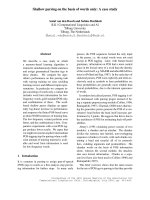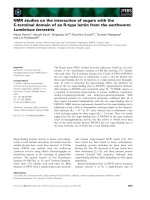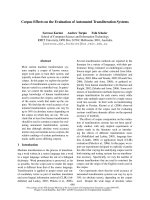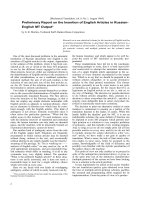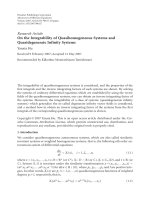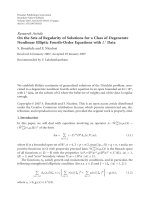Báo cáo toán học: "A note on the number of edges guaranteeing a C4 in Eulerian bipartite digraph" pot
Bạn đang xem bản rút gọn của tài liệu. Xem và tải ngay bản đầy đủ của tài liệu tại đây (81.76 KB, 6 trang )
A note on the number of edges guaranteeing a C
4
in
Eulerian bipartite digraphs
Jian Shen
Department of Mathematics
Southwest Texas State University
San Marcos, TX 78666
email:
Raphael Yuster
Department of Mathematics
University of Haifa at Oranim
Tivon 36006, Israel
email:
Submitted: November 17, 2001; Accepted: March 21, 2002.
MR Subject Classifications: 05C20, 05C35, 05C45
Abstract
Let G be an Eulerian bipartite digraph with vertex partition sizes m,n.We
prove the following Tur´an-type result: If e(G) > 2mn/3thenG contains a directed
cycle of length at most 4. The result is sharp. We also show that if e(G)=2mn/3
and no directed cycle of length at most 4 exists, then G must be biregular. We
apply this result in order to obtain an improved upper bound for the diameter of
interchange graphs.
1 Intro duction
All graphs considered here are finite, directed, and contain no parallel edges. For standard
graph-theoretic terminology the reader is referred to [1]. In this paper we consider the
most basic Tur´an-type problem in bipartite digraphs, namely, specifying conditions on the
cardinality of the edge-set of the digraph that guarantee the existence of a directed simple
cycle of length at most four. As usual in Tur´an type problems in directed graphs, one
must impose constraints relating the indegree and outdegree of a vertex in order to avoid
trivialities (if no such constraints exist then one may not have short directed cycles at all
the electronic journal of combinatorics 9 (2001), #N6 1
even if the graph is very dense, the extreme case being an acyclic orientation of a complete
bipartite graph). The most interesting and natural constraint is the requirement that the
digraph be Eulerian, namely, the indegree of a vertex must be equal to its outdegree.
Let b(m, n) denote the maximum integer, such that there exists an Eulerian bipartite
digraph with vertex partition sizes m, n having b(m, n) edges and no directed cycle of
length at most 4. A biregular bipartite digraph is an Eulerian bipartite digraph having
the property that any two vertices in the same vertex class have the same indegree and
outdegree.
The parameter b(m, n) has been studied by Brualdi and Shen in [3], who proved
b(m, n) <
√
17 −1
mn/4. They conjectured (the case k = 2 of Conjecture 2 in [3]) that
b(m, n) ≤ 2mn/3. In this paper we prove this conjecture, and together with a well-known
construction obtain that it is sharp. Furthermore, we obtain that the extremal graphs
must be biregular. Our main theorem is the following:
Theorem 1.1 b(m, n) ≤ 2mn/3. Equality holds if and only if both m and n are divisible
by 3. Any graph demonstrating an equality must be biregular.
Brualdi and Shen have shown in [3] how an upper bound for b(m, n) corresponds to
an upper bound for the diameter of interchange graphs. These graphs are defined as
follows: Let R =(r
1
, ,r
m
)andS =(s
1
, ,s
n
) be non-negative integral vectors with
r
i
=
s
j
.LetA(R, S)denotethesetofall{0, 1}-matrices with row sum vector R
and column sum vector S, and assume that A(R, S) = ∅. This set has been studied
extensively (see [2] for a survey). The interchange graph G(R, S)ofA(R, S), defined
by Brualdi in 1980, is the graph with all matrices in A(R, S) as its vertices, where two
matrices are adjacent provided they differ in an interchange matrix. Brualdi conjectured
that the diameter of G(R, S), denoted d(R, S), cannot exceed mn/4. Using a result of
Walkup [4] that relates the distance between two vertices A and B in G(R, S)tothe
maximum number of cycles in a cycle decomposition of an Eulerian bipartite digraph
that corresponds to A − B, together with the upper bound for b(m, n), it is shown in
[3] that d(R, S) ≤ (mn + b(m, n))/4. Thus, the result in Theorem 1.1 also improves this
upper bound for d(R, S) giving
d(R, S) ≤
5
12
mn.
It is worth mentioning that in Theorem 1.1, if v is any vertex with maximum normalized
degree (by “normalized degree” we mean the ratio between its outdegree and the cardi-
nality of the opposite vertex class), then there exists a directed cycle of length at most
four that contains v. Thus, there is also a linear O(mn) time algorithm for detecting such
a cycle in these graphs; merely perform a breadth first search whose root is any vertex
with maximum normalized degree.
2 Proof of the main result
Let G =(V,E) be an Eulerian bipartite digraph. We may assume that G does not contain
antiparallel edges, since otherwise G has a directed cycle of length 2 and we are done.
the electronic journal of combinatorics 9 (2001), #N6 2
Let V = A ∪ B where A and B are the two (disjoint) vertex classes of G where |A| = m
and |B| = n.Let0≤ α ≤ 1 satisfy |E| = αmn. In order to prove the upper bound in
Theorem 1.1 we need to show that if α>2/3thenG has a directed C
4
.
For v ∈ V let d
v
denote the indegree and outdegree of v (it is the same by assumption).
For v ∈ A,letρ
v
= d
v
/n and for v ∈ B,letρ
v
= d
v
/m.Letρ =max
v∈V
ρ
v
.Noticethat
G is biregular if and only if ρ
v
= ρ = α/2 for each v ∈ V , or, more compactly, if and only
if ρ = α/2.
Fix v
∗
∈ V satisfying ρ
v
∗
= ρ. Without loss of generality, assume v
∗
∈ A (since
otherwise we can interchange the roles of m and n, as we did not impose any cardinality
constraints upon them). It clearly suffices to prove the following:
Lemma 2.1 If no directed C
4
contains v
∗
as a vertex then α ≤ 2/3.
Proof: We assume that no directed C
4
contains v
∗
as a vertex. Let
A
+
= {w ∈ A :(v
∗
,x) ∈ E =⇒ (x, w) /∈ E}
A
−
= {w ∈ A :(x, v
∗
) ∈ E =⇒ (w, x) /∈ E}.
Since no directed C
4
contains v
∗
as a vertex, we must have that every w ∈ A appears in at
least one of A
−
or A
+
(it may appear in both; in particular, v
∗
appears in both A
−
and A
+
as there are no antiparallel edges). Hence, A
−
∪A
+
= A. Thus, at least one of them has
cardinality at least m/2. Assume, without loss of generality, that |A
+
|≥m/2(otherwise
we can reverse the directions of all edges and the result remains intact). Order the vertices
of A such that A = {v
1
, ,v
m
} and v
1
= v
∗
, v
i
∈ A
+
for i =1, ,|A
+
|,andv
i
∈ A
−
for
i = |A
+
|+1, ,m. Order the vertices of B such that B = {u
1
, ,u
n
} where (v
∗
,u
i
) ∈ E
for i =1, ,ρn,(u
i
,v
∗
) ∈ E for i = ρn +1, ,2ρn. Consider the adjacency matrix of
G, denoted by M,whereM has m rows and n columns, and M(i, j)=1if(v
i
,u
j
) ∈ E,
M(i, j)=−1if(u
j
,v
i
) ∈ E and otherwise M(i, j) = 0. Notice that by our ordering of
the vertices, the upper left block of M does not contain −1. Namely M(i, j) = −1 for
i =1, ,|A
+
| and j =1, ,ρn. Denote this upper left block by M
1
. Also note that,
similarly, M(i, j) = 1 for i = |A
+
| +1, ,m and j = ρn +1, ,2ρn.Denotethisblock
M
2
.DenotebyM
3
the block consisting of the rows i = |A
+
|+1, ,m and the columns
j =1, ,ρn.DenotebyM
4
the block consisting of the rows i = |A
+
|+1, ,mand the
columns j =2ρn+1, ,n.DenotebyM
5
the block consisting of the rows i =1, ,|A
+
|
and the columns j =2ρn +1, ,n. Define β = |A
+
|/m. Figure 1 visualizes these terms.
Let c(s, k) denote the number of entries of M equal to k in the block M
s
for s =
1, 2, 3, 4, 5andk = −1, 0, 1. For normalization purposes, define f(s, k)=c(s, k)/mn.
Consider the following equalities:
f(3, −1) + f(3, 0) + f(3, 1) = ρ(1 −β). (1)
f(1, −1)=0 f(1, 1) = f(3, −1) −f(3, 1) f(1, 0) = ρβ − f(3, −1) + f(3, 1). (2)
f(2, 1)=0 f(2, −1) + f(2, 0) = ρ(1 −β). (3)
the electronic journal of combinatorics 9 (2001), #N6 3
v1
vbm
vbm+1
vm
u1 urn urn+1 u2rn un
M1
M3
M2
1 1
-1 1
0 0
no -1 here
no +1 here
M4
M5
Figure 1: The adjacency matrix M and its blocks
Equality (1) follows from the fact that M
3
contains ρ(1 − β)mn cells. The equalities in
(2) follow from the fact that M
1
does not contain −1 entries, has ρβmn cells, and the
fact that M
1
∪M
3
has the same number of +1 entries as −1 entries (since the graph G is
Eulerian). The equalities in (3) follow from the fact that M
2
does not contain +1 entries,
and has ρ(1 −β)mn cells.
We now show that
(a) 4ρ
2
− 3ρ + α ≤ 2f(3, −1) −f(2, 0),
(b) 2ρ
2
− ρ ≤ f(2, 0) −2f(3, −1) − f (3, 0).
By the definition of ρ, each column of M contains at least (1 − 2ρ)m entries equal to
0. Thus (f(4, 0) + f(5, 0))mn ≥ (1 − 2ρ)
2
mn as M
4
and M
5
together occupy (1 − 2ρ)n
columns of M.SinceM has exactly (1 − α)mn entries equal to 0, we have
(1 −α)mn ≥ mn
5
i=1
f(i, 0) ≥ (f(1, 0) + f(2, 0) + f(3, 0))mn +(1− 2ρ)
2
mn;
that is,
1 − α ≥ f(1, 0) + f(2, 0) + f(3, 0) + (1 − 2ρ)
2
. (4)
By equality (2) we know that f(1, 0) = ρβ − f(3, −1) + f(3, 1) and by equality (1) we
have f(3, −1) + f(3, 0) + f(3, 1) = ρ(1 −β). Using these equalities and inequality (4) we
have
1 −α ≥ ρβ − f(3, −1) + f(3, 1) + f(2, 0) + f(3, 0) + (1 −2ρ)
2
= ρβ − 2f(3, −1) + f(2, 0) + ρ(1 − β)+(1−2ρ)
2
= −2f(3, −1) + f(2, 0) + 4ρ
2
− 3ρ +1,
the electronic journal of combinatorics 9 (2001), #N6 4
giving inequality (a).
To prove inequality (b), let M
be the submatrix of M consisting of rows βm+1, ,m
and all columns of M. Since each column of M contains at most ρm entries equal to 1,
we have
(f(4, 1) + f(5, 1))mn ≤ ρm(1 − 2ρ)n.
Since G is bipartite Eulerian, the number of −1’s in M
equals the number of 1’s in M
.
Thus,
(f(2, −1) + f(3, −1) + f(4, −1))mn =(f(2, 1) + f(3, 1) + f(4, 1))mn
=(f(3, 1) + f(4, 1))mn
≤ f(3, 1)mn +(f(4, 1) + f(5, 1))mn
≤ f(3, 1)mn + ρ(1 −2ρ)mn,
which implies,
f(2, −1) + f(3, −1) ≤ f(3, 1) + ρ(1 −2ρ).
Since f(3, 1) + f(3, −1) + f (3, 0) = ρ(1 − β)=f(2, 0) + f(2, −1), we have
ρ(2ρ −1) ≤ f(3, 1) −f(2, −1) −f(3, −1)
= f(2, 0) −2f(3, −1) −f(3, 0),
proving inequality (b).
Adding inequalities (a) and (b) we have 6ρ
2
−4ρ + α ≤−f(3, 0) ≤ 0. Thus
α ≤−6ρ
2
+4ρ = −6
ρ −
1
3
2
+
2
3
≤
2
3
.
Proof of Theorem 1.1: The last inequality shows that b(m, n) ≤ 2mn/3. Now, suppose
G is an Eulerian bipartite digraph with edge density exactly 2/3 and no directed cycle of
length at most 4. The last inequality shows that in this case we must have ρ =1/3=α/2.
Hence, G must be biregular and the cardinality of each vertex class of G must be divisible
by 3. For any pair m and n both divisible by 3 it is easy to construct a biregular Eulerian
bipartite digraph with edge density 2/3 and no directed C
4
nor antiparallel edges. We use
a construction from [3]. Let |M
0
| = |M
1
| = |M
2
| = m/3andlet|N
0
| = |N
1
| = |N
2
| = n/3.
Construct a bipartite graph with vertex classes M = M
0
∪M
1
∪M
2
and N = N
0
∪N
1
∪N
2
.
Create all possible directed edges from M
i
to N
i
, i =0, 1, 2 and from N
i
to M
i+1
i =0, 1, 2
(modulo 3). Clearly this graph has no antiparallel edges and no directed C
4
.Itisbiregular
and has 2mn/3 edges. This completes the proof of Theorem 1.1.
References
[1] B. Bollob´as, Extremal Graph Theory, Academic Press, London, 1978.
[2] R.A. Brualdi, Matrices of zeros and ones with fixed row and column sum vectors,
Linear Algebra Appl. 33 (1980), 159-231.
the electronic journal of combinatorics 9 (2001), #N6 5
[3] R.A. Brualdi and J. Shen, Disjoint cycles in Eulerian digraphs and the diameter of
interchange graphs, J. Combin. Theory Ser. B, to appear.
[4] D.W. Walkup, Minimal interchanges of (0, 1)-matrices and disjoint circuits in a
graph, Canad. J. Math 17 (1965), 831-838.
the electronic journal of combinatorics 9 (2001), #N6 6
